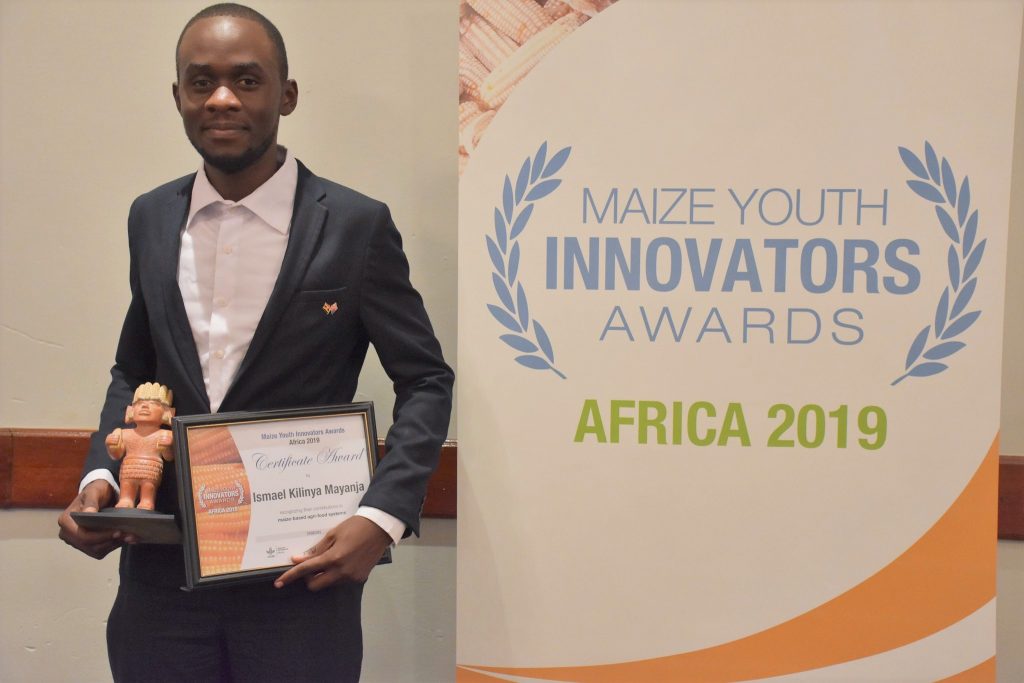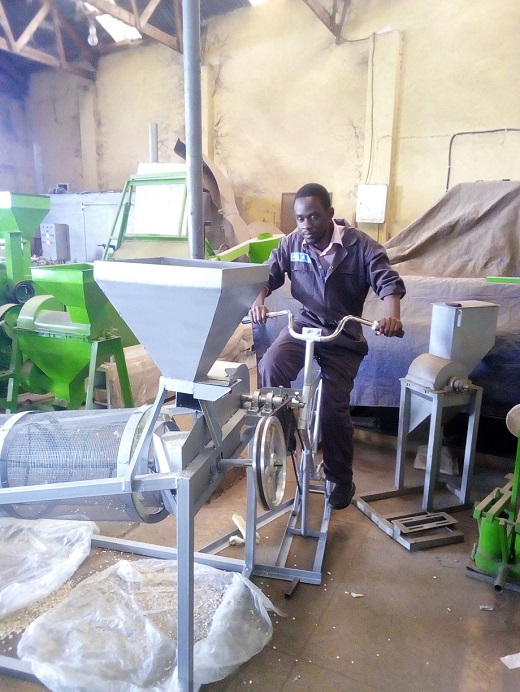
Young innovator develops bicycle-powered maize cleaning machine to help schoolchildren
By Jennifer Johnson
Ismael Mayanja never intended to work in agriculture, but knew he wanted to make a positive impact on his country. The 23-year-old engineer was recently awarded the 2019 MAIZE Youth Innovators Award – Africa in the category of “researcher” for his work developing a bicycle-powered maize cleaning machine that reduces labor time and improves the health of school children in his native country, Uganda.
These awards, an initiative of the CGIAR Research Program on Maize (MAIZE), recognize the contributions of young women and men below 35 years of age who are implementing innovations in African maize-based farming systems. This is the second year of the awards, and the first time to be held in Africa. The award ceremony took place in Lusaka, Zambia during the annual Stress Tolerant Maize for Africa (STMA) project meeting May 7-9, 2019.

Q: What inspired you to work in agriculture?
A: I’ve always wanted to work on innovative solutions to the world’s challenges, and I wanted to go into a field that has room for innovation. Agriculture is a main contributor to the economy of Uganda, and if the country is to go forward, we must improve agriculture. I am very inspired to help improve my country, which is why I went into agricultural engineering to help improve and develop the designs and technologies for agricultural machines.
Q: What inspired you to develop this innovation?
A: In all primary education schools in Uganda, parents are required to pay a school fee. In some districts such as Kamuli, if a parent cannot afford to pay, they are given the option to instead contribute maize as tuition to feed the students. However, they often don’t have the technology to properly clean the maize. There may be crushed cobs or broken kernels that make the maize more vulnerable to mold infestation during storage, posing a health risk to children.
To reduce this risk, all children at the school used to have to clean maize for two hours each week, using inefficient traditional methods. This is precious time that is taken away from their schoolwork.

I learned about this issue during my internship in Uganda with the Iowa State University Uganda Program, a partnership between Iowa State University and Makerere University. I got in touch with Dr. Thomas Brumm, a professor at Iowa State University, and told him about my desire to help my country through improving agricultural machinery. He mentioned that maize cleaning was a major problem at the schools and recommended that I use rotary motion as a cleaning mechanism for a maize cleaner. I consulted with many friends and professors before I finally came up with the final design of using a bicycle-powered maize cleaning machine.
The machine is very easy to use: one child pedals the bike, another pours in the maize, and the other collects the cleaned maize from the outlet. Best of all, the kids love it! They keep yelling “my turn, my turn!” They think it is a game!
Before, it would take 100 children to clean 722 kg of maize in one hour. Now, with the bicycle-powered machine, just three children can clean 714.23 kg of maize in one hour, a 327% increase in efficiency that allows students to spend less time cleaning maize and more time in the classroom. In addition, this new machine is cleaning efficient to 83.11%, compared to time-consuming traditional maize cleaning methods that are only 30-60% cleaning efficient. This increased efficiency reduces the risk of mold contamination in schoolchildren’s food.
Q: What sets your innovation apart from other maize cleaning machines?
A: Advanced machines exist to clean maize but they are not frequently used in rural Uganda as they are very expensive — not just the initial costs but also the cost of operation, as these machines require either engines that require fuel or motors that use electricity. They also have high maintenance costs, as these machines are quite sophisticated and not everyone knows how to fix them.
A bicycle is cheap, everyone knows how to use it, and it requires no fuel or electricity and produces no pollution. It is silent and does not produce noise pollution like models with engines. Also, motor and engine-powered machines frequently clean using vibration mechanism, which can damage up to 20% of the maize grain. The bicycle model uses rotary motion to clean, not vibration, therefore damaging only 2% of grain.
Motor and engine-run maize cleaning machines tend to run from $700-900 USD. The bicycle prototype only cost $402 USD to develop, and we will be able to manufacture it in the future for as little as $260 USD, a fraction of the price. My machine is shared by three schools, benefitting an estimated 2,400 students.

Q: What are your hopes for the future?
A: Right now, I am working to improve the design and functionality of the machine, and to produce more prototypes. In the future, I would like to offer this innovation to farmers in addition to schools. Many farmers currently have low bargaining power for selling their maize, as the maize they sell is not very clean due to inefficient traditional cleaning methods. If they could bring clean maize grain to the market, they would have much better bargaining power and would be able to earn more.
I would also like to develop a fabrication unit for innovations that would provide a platform for young people to develop a passion for agriculture through innovation and in turn revolutionize agriculture in Uganda and the world at large.
Q: What advice do you have for other young people interested in agriculture?
A: Young people must realize that agriculture is the future, and to succeed in life you must always be in the future. You must love what you do, because if you love what you do, innovation and inventiveness become second nature to you.

2019 MAIZE Youth Innovators Awards, Africa, innovation, Maize, MYIA 2019, Uganda
